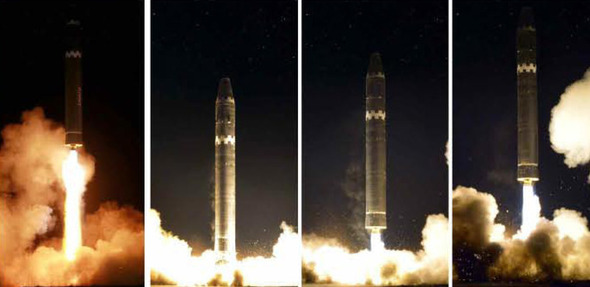 |
|
Photos of the Hwasong-15 missile launch that appeared in the Rodong Shinmun
|
Remarks are aimed at preventing US and North Korea from escalating tense situation
Attention is focusing on the reasons why South Korean President Moon Jae-in told US President Donald Trump in a phone call on Nov. 30 that North Korea’s Hwasong-15 missile has not been completely developed. While Moon was primarily raising doubts about the ICBM’s technical completion, experts believe that he was also sending a message to the US and North Korea not to allow rash conclusions to lead them into a fatal collision. The Hwasong-15, Moon said during the phone call, “is clearly the most advanced missile to date which North Korea has developed, but its technology for reentry and for guidance in the terminal stage have not yet been proven, nor is it certain whether [North Korea] has acquired the technology for miniaturizing nuclear warheads.” That was the response Moon made when Trump asked him what he thought about North Korea’s missile. Moon has not accepted the claims of the North Korean government that it has completed its ICBM program and its “state nuclear force.” The first reason that Moon responded in this way is because of the South Korean government’s technical assessment. Before speaking on the phone with Trump, Moon reportedly was briefed on the Hwasong-15 by the National Security Office. Moon was apparently told that, while the missile can be classified as an ICBM in terms of distance traveled, its atmospheric reentry, precision guidance in the terminal phase and warhead operation were not demonstrated because the test launch was not actually carried out at the normal angle. “The distance shows a definite improvement, but no one can confirm whether it is completed on a technical level,” said a senior official at the Blue House. Similarly, the Defense Ministry told the National Assembly’s National Defense Committee in a briefing on Dec. 1 that the missile “is judged to be a new ICBM in light of its flight characteristics and its appearance. It is capable of flying more than 13,000 km when launched at the standard angle.” But as for atmospheric reentry technology, the Ministry said that “additional assessment would be necessary.” Moon’s remarks also appear to represent a request for the US and North Korea not to make a hasty judgment about the situation. “We must prevent a situation in which North Korea misjudges the situation and blackmails us with nuclear weapons or in which the US contemplates a preemptive strike,” Moon said during a full session of the National Security Council (NSC) over which he presided on the day of North Korea’s missile test launch. In effect, Moon asked the US not to resort to a preemptive strike when North Korea has not completed its development of ICBMs equipped with a nuclear warhead. This can also be seen as a warning to North Korea that any further provocations could lead to an unpredictable situation. Moon’s message also reflects the concern that acknowledging North Korea’s claim that it has completed its ICBM development and its state nuclear force could make the North Korean nuclear issue even harder to resolve. “Accepting North Korea’s announcement at face value means recognizing North Korea as a nuclear weapon state. That would further limit the options for dialogue and negotiations for North Korea that the government has been pursuing,” said a Blue House official. Some experts believe that Moon’s remarks are also designed to rebut the arguments of conservative parties in the opposition who take for granted that North Korea has completed its ICBM development and are using that to attack the government on national security. By Seong Yeon-cheol, staff reporter Please direct questions or comments to [english@hani.co.kr]






